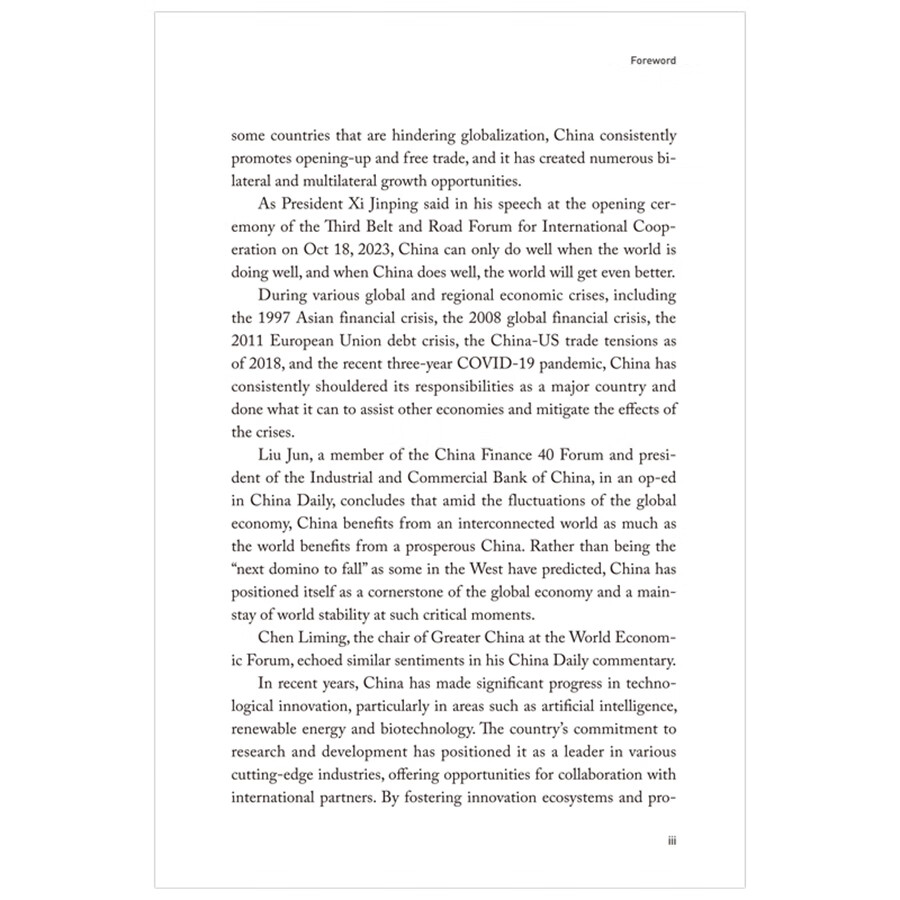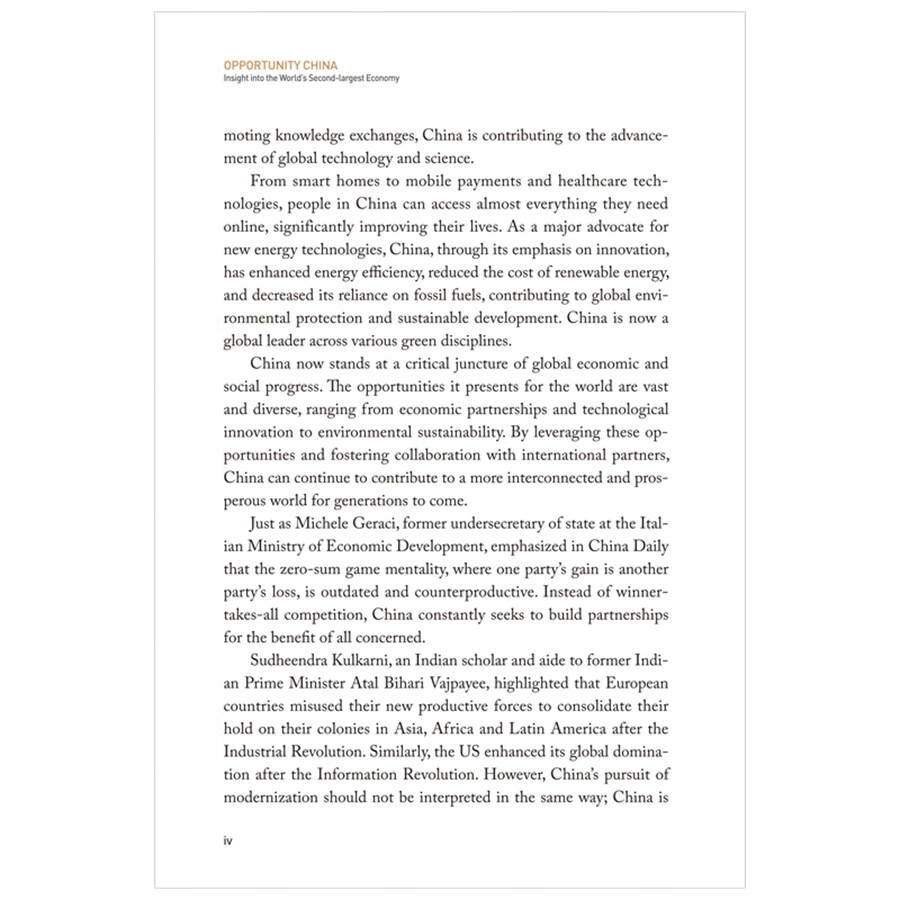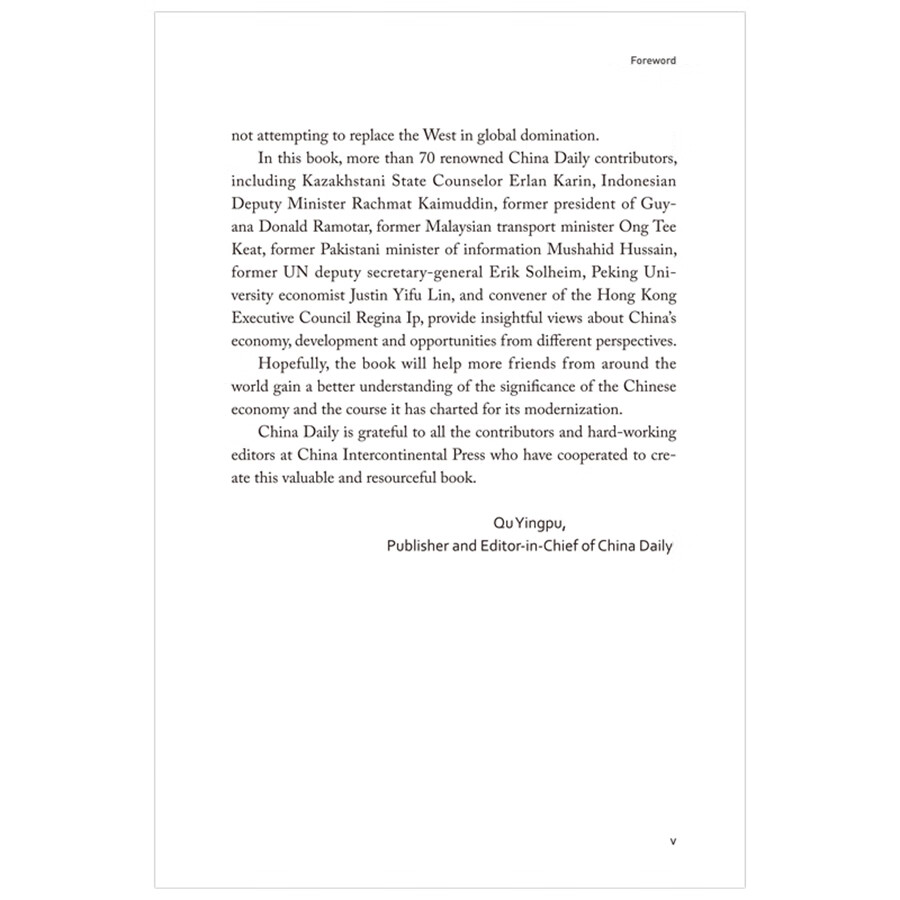Details
A tale of China’s economic resilience should be retold By Liu Jun We live in a world where the growth momentum has weakened, and countries have taken on divergent recovery paths. Uncertainties in global trade, geopolitical tensions and monetary policies further complicate the picture. But despite the ups and downs of the global economy, China benefits from an integrated world as much as the world benefits from a prosperous China. China remains a major global economic player as the world’s second-largest economy. Yet an important but often overlooked question is: “What does China really mean to the global economy?” The answer becomes apparent through the lens of concrete historical data. During the 1997 Asian financial crisis, the stability of the renminbi was critical to preventing risk escalation, while the 2008 global financial crisis saw China’s economic stimulus package helping other economies emerge out of recession. And during the 2011 European Union debt crisis, China increased exports to Europe to help ease the pressure the crisis had caused. Besides, amid the US-China trade tensions in 2018, China acted as a responsible global player through active negotiations and concrete actions. During the three-year COVID-19 pandemic through delivering a swift rebound and a robust prop-up in manufacturing, China further demonstrated its pivotal role in the global supply chains. By 2023, China had consistently contributed more than 30 percent to the global GDP growth for a decade. China a great contributor to global economy At each critical moment of global or regional economic crises, instead of being the “next domino to fall” as many estimated, China positioned itself as a cornerstone and stabilizer of the global economy. The reasons for that are fourfold. First, China has the most comprehensive industrial system in the world. It is the only country with all the industrial categories defined by the UN International Standard Industrial Classification of All Economic Activities. China became the world’s leading manufacturer in 2010 and has maintained that status till date. In 2023, China accounted for about 35 percent of the global manufacturing output and 30 percent of the added value, according to the Organisation for Economic Co-operation and Development. China’s economy of scale and interwoven industrial chain boost efficiency and reduce costs for itself as well as the rest of the world. The world’s access to affordable, high-quality, made-in-China products plays a crucial role in tempering global inflation. Since 2020, geopolitical tensions and the West’s efforts to “decouple” from the Chinese economy have disrupted global supply chains. While the US and the EU were busy sounding alarm bells of inflation, China kept its consumer price index at a reasonable level. As such, China’s critical contribution to stimulating global economic growth while managing inflation merits greater recognition. Second, China pledges to adhere to the rulebook in global trade and beyond. Allegations that China is a rule-breaker are groundless given the hard evidence that prove otherwise. Since joining the World Trade Organization, China has amended thousands of laws and regulations — 2,300 at the central level and 190,000 at the local level — to ensure conformity with the WTO rules and its commitments. As of 2021, China has successfully reduced its import tariff to 7.4 percent, well below its initial commitment of 9.8 percent, down to the levels seen in developed countries. And it has withdrawn non-tariff restrictive measures significantly, including such as import quota, as promised. As a matter of fact, China’s adherence to rule-based engagement in international trade has been richly rewarded, as it now stands at the very heart of global commerce. It ranks No 1 in the world in terms of trade in goods and second in terms of services. China has also forged strong partnerships with more than 140 countries. Having gained and done so much in the global commercial ecosystem, China would be the last one to break it. So even in the face of the complexity of modern trade, China will continue to be a dedicated player, working with other countries to perfect the rules. With development programs such as Belt and Road Initiative, the WTO reform proposal and membership of the Regional Comprehensive Economic Partnership, China has contributed to refinement of the global trading system. Giving a voice to all participants, big or small, South or North, developed or underdeveloped, is the key to devising fairer and more nuanced global economic norms. Third, the significance of the opening-up of China’s economy is a tale that can never be told enough. Four decades of experience shows that an advanced manufacturing system emerges from deeper global integration. The inflow of capital in the form of foreign direct investment, and advanced technologies and talents to China has facilitated the country’s industrial upgrading, with the Yangtze and Pearl river delta manufacturing hubs witnessing thousands of producers ascending to the medium-high end of global industrial chains by leveraging foreign know-how. China’s recent push for a dual-circulation development paradigm might, at first glance, seem like a step toward more self-reliance. Yet on closer look, it indicates China will further open up its economy to the outside world. Perhaps China knows that enhanced synergy with the global economy is required for expanding and elevating domestic circulation more than any other country. Since the 1990s, at least some manufacturing in all countries has gone global. For more than three decades, companies have been strategically distributing operations worldwide. To make iPhone, for example, Apple assembles more than 1,000 parts from the United States, the Republic of Korea, Japan, China and other countries, which shows how intertwined the production process has become......
Table of Contents
Foreword
Ⅰ. Chinese economic resilience: A story worth retelling
A tale of China’s economic resilience should be retold
West should see China’s rise as opportunity
China remains a powerhouse of global economy
China seeks better lives for the people
China’s planning conducive to growth
Qualitative development a new benchmark for growth
Worries about China’s reform unwarranted
Why ‘quality’ Western media push fake GDP news
Socialist market system drives growth
Ⅱ. New quality productive forces driving innovation
China makes innovation new engine of growth
Why West misreads new development paradigm
New quality productive forces driving transformation
Nation charts course toward modernization
Digital technology can boost economic recovery
China’s advancements in global innovation dynamics inspiring
Techno-industrial upgrade fuels development
New quality productive forces need new industrialization
New infrastructure can boost economy
Smart transport drives high-quality growth
Company innovations boost resilient economy, benefit consumers
‘Patient capital’ boosts new quality productivity
Ⅲ. Realizing potential of primary, secondary, and tertiary industries
High-tech can help boost food security
Sino-German agri-cooperation for mutual benefit
The young lead new trends in consumption market
Do you prefer digital ‘red envelopes’?
Stable RMB conducive to high quality development
Yuan meets all criteria to be a cross-border trade currency
Market, rule of law at core of SOEs’ reform
Private firms can play bigger role in quality growth
Unified market will tap economic potential
Improve standardization to build a unified market
Ample room for growth of realty sector
Urban renewal key to building smart cities
Cultural industry can better tell China story
Inbound tourism recovery key to overall sector’s health
Ⅳ. Regional strategies to boost overall development
HK pearl of Greater Bay Area
Macao bridges China, Portuguese-speaking nations
GBA facilitates robust SMEs’ development
G60 corridor to boost innovation
Northeast China eyeing economic renaissance
Western region seeks quality growth
The heartland poised for a historic leap
Universities’ shift to Xiong’an serves dual purpose
Ⅴ. Golden opportunities behind the ‘silver economy’
Aging a challenge but also an opportunity
Innovation new key to old problem of aging population
Rising aging population does not necessarily slow down modernization
‘Silver economy’ could create golden opportunities
All older people can benefit from ‘silver economy’
Ⅵ. Glittering chances in green transition
Green power pilots new energy system
Chinese devotion to shared sustainable future
Low-carbon progress not equal to slow growth
China devoted to a shared green future
At the front of world’s energy transition
Leverage critical minerals for Africa’s growth
Ⅶ. China’s growth, world’s opportunities
Innovation inspires China’s competitiveness
Boosting China’s exports amid global restructuring
Innovative workforce crucial for future reform
Infrastructure cooperation could be an option
For an innovative France-China partnership
China-EU synergy can meet global challenges
China’s growth offers opportunities to Europe
Move forward with ASEAN amid challenges
Indonesia’s EV sector open for business
Building RCEP region into a big market
Expediting digital trade contributes to modernization
Railways help landlocked Laos embark on a journey beyond borders
Asia-Pacific FTAs can coexist
ROK can ride China’s quality development
RCEP for green and sustainable development
China-Brazil ties set to open new chapter
Australia, China can put trade ties back on track
Sino-Kazakh shared path to prosperity
CPEC fully proves its real worth
Only BRI truly meets infrastructure needs
Chinese modernization benefits world
BRI boosts Sri Lanka’s status as logistics hub
Initiative rooted in history but oriented toward future
China’s development enlightening for Global South
China a key peaceful player in Global South




